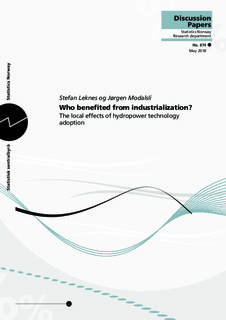| dc.contributor.author | Leknes, Stefan | |
| dc.contributor.author | Modalsli, Jørgen | |
| dc.date.accessioned | 2018-09-04T13:30:28Z | |
| dc.date.available | 2018-09-04T13:30:28Z | |
| dc.date.issued | 2018-05-02 | |
| dc.identifier.issn | 1892-753X | |
| dc.identifier.uri | http://hdl.handle.net/11250/2560771 | |
| dc.description.abstract | This paper studies the impact of the construction of hydropower facilities on labor market outcomes in Norway at the turn of the twentieth century (1891-1920).
The sudden breakthrough in hydropower technology provides a quasi-experimental setting, as not all municipalities had suitable natural endowments and the possible production sites where often located in remote areas. We find that hydropower municipalities experienced faster structural transformation and displayed higher occupational mobility. Unskilled workers and workers from low-status families did to a greater extent obtain skilled jobs in hydropower municipalities. We interpret this as evidence that this early twentieth-century technology was skill-biased, and that workers in the new skilled jobs were recruited from a broad segment of the population. However, areas affected by the new technology also experienced occupational polarization, with an increase in high- and low-skilled manual jobs at the expense of intermediate-skilled jobs. | nb_NO |
| dc.language.iso | eng | nb_NO |
| dc.publisher | Statistisk sentralbyrå | nb_NO |
| dc.relation.ispartofseries | Discussion Papers;No. 874 | |
| dc.subject | Vannkraft | nb_NO |
| dc.title | Who benefited from industrialization? The local effects of hydropower technology adoption | nb_NO |
| dc.type | Working paper | nb_NO |
| dc.subject.nsi | VDP::Landbruks- og Fiskerifag: 900::Landbruksfag: 910::Naturressursforvaltning: 914 | nb_NO |
| dc.source.pagenumber | 50 s. | nb_NO |
